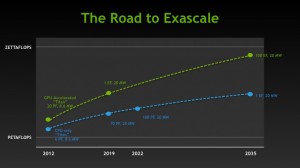Exascale refers to quintillion flops, or a billion gigaflops.
Exascale: An Innovator’s Dilemma
NVIDIA CEO Jen-Hsun Huang gave an electrifying opening keynote today at SC11, the annual gathering of the international supercomputing community, as it gears up for the industry’s next grand challenge: exascale computing.
He began his presentation by discussing Clayton Christensen, the Harvard Business School professor who literally wrote the book on innovation, The Innovator’s Dilemma. Christensen gave the keynote at last year’s event, SC10, where he shared the basic principles of his theory, which at its simplest states that disruptive technologies are not initially deemed valuable to the markets they eventually serve.
Disruptive technologies are typically cheaper, less advanced and spring from low-margin markets. By their nature, they fly in the face of the forces that govern large, established companies. And yet history is on their side. The steady progression of the computing industry – from mainframes to mini computers to workstations to PCs to today’s mobile devices – can be read as successive waves of disruptive innovation.
Huang described how Christensen’s model applies to the supercomputing industry and the processors at its core.
The limitations of power
 |
| This graph, shown during Jen-Hsun Huang’s SC11 keynote, shows the projected time to reach exascale performance with and without GPU technology. |
For much of the past two decades, computer scientists were able to steadily improve the supercomputer performance by scaling out ever-larger CPU-powered systems. However, Huang argued that this approach has hit a wall. Due to the energy required to power them, it’s no longer practical to scale out CPU-only systems. And in the context of the exascale challenge, power is paramount. To achieve the goal of 1 exaflop at 20 megawatts by 2019, a CPU-only system would arrive more than 15 years late, in 2035. “Energy efficiency is our single greatest imperative,” said Huang.
Enter the GPU. While CPUs are comprised of a handful of cores optimized for linear tasks, GPUs are comprised of many cores optimized for parallel computing and are dramatically more ener...